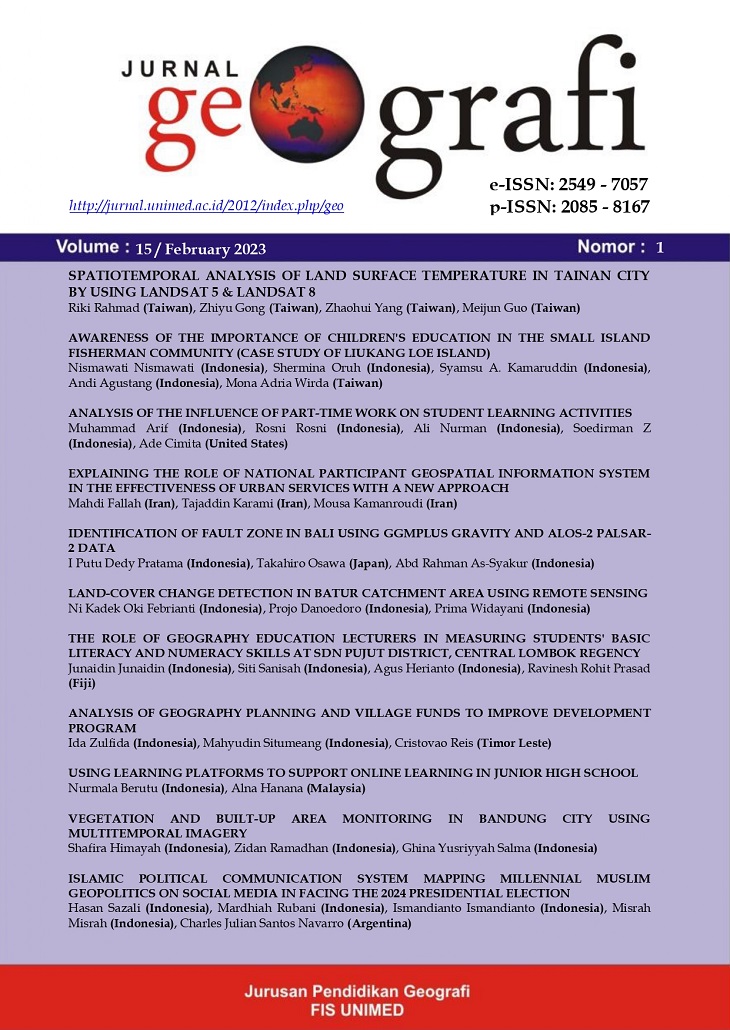Using Learning Platforms to Support Online Learning in Junior High School
DOI:
https://doi.org/10.24114/jg.v15i1.42772Abstract
The online learning process can be done through various e-learning platforms. The determination of the platform should consider the dimensions of the teacher and those of the students. This study aims to analyze the use of the e-learning platform from the perspective of teachers and students in junior high school. This quantitative research design uses a descriptive method. Participants consisted of 91 teachers and 165 students in Medan City. Data were collected by questionnaire via Google Forms. Quantitative data analysis used descriptive statistics to obtain the percentages for each indicator. Then the presentation of data is done with tables and diagrams. The results showed that teachers and students have different perspectives on each e-learning platform supporting the learning process. Based on the philosophy of teachers and students, it can be stated that 1) teachers and students prefer Google Classroom to Edmodo as an LMS in Online Learning. This is because Google Classroom is easier to use, more interactive, and more efficient; 2) Google Meet is the application most often used and preferred by teachers and students in direct virtual Learning. Even though Zoom Cloud Meeting has a more attractive appearance and features, Google Meet is easier to access and considered to save internet quota; 3) As many as 43% of teachers and 49% of students prefer a combination of Google Classroom, Google Meet, WA Group to support the online learning process. Meanwhile, 41% of teachers and 42% of students prefer a combination of Google Classroom, Zoom Cloud Meeting, and WA Group as an e-learning platform. Only a few teachers and students choose the variety of Edmodo Zoom and WhatsApp groups and the combination of Edmodo, Google Meet, and WhatsApp groups.Keywords: E-Learning Platform, Student Perspective, Teacher PerspectiveReferences
Abid Azhar, K., & Iqbal, N. (2018). Effectiveness of Google Classroom: Teachers' Perceptions. Prizren Social Science Journal, 2(2), 52“66.
Al-Maroof, R. A. S., & Al-Emran, M. (2018). Students acceptance of google classroom: An exploratory study using PLS-SEM approach. International Journal of Emerging Technologies in Learning, 13(6), 112“123. https://doi.org/10.3991/ijet.v13i06.8275
Barbosa, T. J. G., & Barbosa, M. J. (2019). Zoom: An Innovative Solution For The Live-Online Virtual Classroom. HETS Online Journal, 9(2). https://link.gale.com/apps/doc/A596061565/AONE?u=anon~e0d5cfec&sid=googleScholar&xid=748ee531
Basilaia, G., & Kvavadze, D. (2020). Transition to Online Education in Schools during a SARS-CoV-2 Coronavirus (COVID-19) Pandemic in Georgia. Pedagogical Research, 5(4). https://doi.org/10.29333/pr/7937
Berutu, N., Delita, F., Astuti, A. J. D., Novira, N., & Wirda, M. A. (2019). The Strategy to Strengthen Information Literacy Based on Library and Digital Resources. International Conference on Social Sciences and Interdisciplinary Studies, 208. https://doi.org/10.2991/icssis-18.2019.28
Çevikbaş, M., & Argün, Z. (2017). An Innovative Learning Model in Digital Age: Flipped Classroom. Journal of Education and Training Studies, 5(11), 189. https://doi.org/10.11114/jets.v5i11.2322
Clandinin, D. J., & Connelly, F. M. (2000). Narrative Inquiry (Experience and Story in Qualitative Research). Jossey-Bass an Imprint of Wiley.
Delita, F. (2021). The Challenges of E-Learning Implementation During the Covid-19 Pandemic in Senior High School. Journal of Digital Learning and Education, 1(3), 150“157. https://doi.org/10.52562/jdle.v1i3.257
Delita, F., Arif, M., Rosni, Sitompul, M., & Rohani. (2019). Improving the Quality of Learning Through Assignment System. Journal of Physics: Conference Series, 1175(1). https://doi.org/10.1088/1742-6596/1175/1/012154
Delita, F., Berutu, N., & Nofrion. (2022). Online Learning: The Effects of Using E-Modules on Self-Efficacy, Motivation, and Learning Outcomes. Turkish Online Journal of Distance Education, 23(4), 0“3. https://doi.org/10.17718/tojde.1182760
Delita, F., Berutu, N., Sidauruk, T., Elfayetti, & Herdi. (2022). Measuring Digital Literacy Skills Among Students in Senior High School. Jurnal Geografi, 14(1), 99. https://doi.org/10.24114/jg.v14i1.31234
Eady, M. J., & Lockyer, L. (2013). Tools for Learning: technology and teaching strategies, Learning to Teach in the Primary School. Queensland University of Technology, Australia, 71“89. https://ro.uow.edu.au/asdpapers/403
Gunawan, Suranti, N. M. Y., & Fathoroni. (2020). Variations of Models and Learning Platforms for Prospective Teachers During the COVID-19 Pandemic Period. Indonesian Journal of Teacher Education, 4(3), 1“4.
Khoza, S. B., & Biyela, A. T. (2020). Decolonizing technological pedagogical content knowledge of first-year mathematics students. Education and Information Technologies, 25(4), 2665“2679. https://doi.org/10.1007/s10639-019-10084-4
Koehler, M. J., Mishra, P., & Cain, W. (2009). What is Technological Pedagogical Content Knowledge (TPACK)? Contemporary Issues in Technology and Teacher Education, 9(1), 60“70. https://doi.org/10.1177/002205741319300303
Maske, S. S., Kamble, P. H., Kataria, S. K., Raichandani, L., & Dhankar, R. (2018). Feasibility, Effectiveness, and Students' Attitude Toward Using WhatsApp in Histology Teaching and Learning. Journal of Education and Health Promotion, 1“6. https://doi.org/10.4103/jehp.jehp
Mpungose, C. B., & Khoza, S. B. (2022). Postgraduate Students™ Experiences on the Use of Moodle and Canvas Learning Management System. Technology, Knowledge and Learning, 27(1), 1“16. https://doi.org/10.1007/s10758-020-09475-1
O'Flaherty, J., & Phillips, C. (2015). The use of flipped classrooms in higher education: A scoping review. Internet and Higher Education, 25, 85“95. https://doi.org/10.1016/j.iheduc.2015.02.002
Prensky, M. (2001). Digital Natives, Digital Immigrants Part 1. On the Horizon, 9(5), 1“6. https://doi.org/10.1108/10748120110424816
Rohman, M. F., & Mistofa, A. (2017). Google Classroom: Jadikan Kelas Digital di Genggaman Anda (p. 103). Bojonegoro: Pustaka Intermedia.
Shaharanee, I. N. M., Jamil, J. M., & Rodzi, S. S. M. (2016). Google Classroom as a Tool for Active Learning. AIP Conference Proceedings, 1761(June 2018). https://doi.org/10.1063/1.4960909
Sojanah, J., Suwatno, Kodri, & Machmud, A. (2021). Factors affecting teachers' technological pedagogical and content knowledge (A survey on economics teacher knowledge). Cakrawala Pendidikan, 40(1), 1“16. https://doi.org/10.21831/cp.v40i1.31035
Sumardi, S., & Muamaroh, M. (2020). Edmodo impacts: Mediating digital class and assessment in english language teaching. Cakrawala Pendidikan, 39(2), 319“331. https://doi.org/10.21831/cp.v39i2.30065
Sutterlin, J. (2018). Learning is Social with Zoom Video Conferencing in your Classroom. ELearn, 12.
Tillman, M., & Willings, A. (2020). What is Zoom, and how does it work? Plus, tips and tricks.
Turnbull, Darren, Chugh, R., & Luck, J. (2019). Learning management system: An overview. Encyclopedia of Education and Information Technologies, 1“7.
Ventayen, R. J. M., Estira, K. L. A., Guzman, M. J. De, & Cabaluna, Christian Mark Espinosa, N. N. (2018). Usability Evaluation of Google Classroom: Basis for the Adaptation of GSuite E-Learning Platform Software Management View project Data Analysis View project. Asia Pacific Journal of Education, Arts, and Sciences, 5(1), 47“51.







